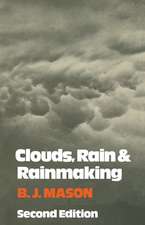Computational Hydraulics: An Introduction
Autor Cornelis B. Vreugdenhilen Limba Engleză Paperback – 26 iun 1989
Preț: 384.09 lei
Nou
Puncte Express: 576
Preț estimativ în valută:
73.50€ • 76.93$ • 61.17£
73.50€ • 76.93$ • 61.17£
Carte tipărită la comandă
Livrare economică 31 martie-14 aprilie
Preluare comenzi: 021 569.72.76
Specificații
ISBN-13: 9783540506065
ISBN-10: 3540506063
Pagini: 196
Ilustrații: VIII, 182 p.
Dimensiuni: 170 x 244 x 10 mm
Greutate: 0.32 kg
Ediția:Softcover reprint of the original 1st ed. 1989
Editura: Springer Berlin, Heidelberg
Colecția Springer
Locul publicării:Berlin, Heidelberg, Germany
ISBN-10: 3540506063
Pagini: 196
Ilustrații: VIII, 182 p.
Dimensiuni: 170 x 244 x 10 mm
Greutate: 0.32 kg
Ediția:Softcover reprint of the original 1st ed. 1989
Editura: Springer Berlin, Heidelberg
Colecția Springer
Locul publicării:Berlin, Heidelberg, Germany
Public țintă
ResearchCuprins
1. Introduction.- 2. Water quality in a Lake.- 2.1. Mathematical Formulation.- 2.2. Exercises.- 3. Numerical solution for Box Model.- 3.1 Principle.- 3.2 Stability and Accuracy.- 3.3. Example.- 3.4. Implicit Method.- 3.5. Exercises.- 4. Transport of a Dissolved Substance.- 4.1. Mathematical Formulation.- 4.2. Numerical Solution.- 4.3. Exercises.- 5. Explicit Finite-Difference Methods.- 5.1. Two-Level Methods.- 5.2. The Leap-Frog Method.- 5.3. The CFL Condition.- 5.4. Truncation Error.- 5.5. Wave Propagation.- 5.6. Exercises.- 6. Kinematic waves.- 6.1. Theory.- 6.2. Example.- 7. Diffusion.- 7.1. Groundwater Flow in a Horizontal Layer.- 7.2. Explicit Finite-Difference Method.- 7.3. Implicit Finite-Difference Method.- 7.4. The Thomas Algorithm.- 7.5. Application.- 7.6. Exercises.- 8. Numerical Accuracy for Diffusion Problems.- 8.1. Fourier Series.- 8.2. Transfer Function.- 8.3. Numerical Representation.- 8.4. Exercises.- 9. Diffusion Model for Coastline Development.- 9.1. Mathematical Formulation.- 9.2. Initial and Boundary Conditions.- 9.3. Example.- 9.4. Exercises.- 10. Consolidation of Soil.- 10.1. Mathematical Formulation.- 10.2. Numerical Example.- 11. Convection—Diffusion.- 11.1. Transport of a Dissolved Substance.- 11.2. Numerical Method.- 11.3. Application.- 11.4. Exercises.- 12. Numerical Accuracy for Convection—Diffusion.- 12.1. Wave Propagation.- 12.2. Example.- 12.3. Numerical Diffusion.- 12.4. Example.- 12.5. Convection only.- 12.6. Wiggles.- 12.7. Exercises.- 13. Salt intrusion in Estuaries.- 13.1. Formulation.- 13.2. Accuracy Mean Concentration.- 13.3. Accuracy for Tidal Fluctuation.- 14. Boundary Layers.- 14.1. Suspended Sediment Transport.- 14.2. Example.- 14.3. Boundary-Layer Flows.- 14.4. Pressure Gradient.- 14.5. Developing Flow in a River.- 14.6.Exercises.- 15. Long Waves.- 15.1. Simplified Formulation.- 15.2. Characteristics.- 15.3. Weakly Reflecting Boundary Conditions.- 15.4. Example.- 15.5. Wave Propagation.- 15.6. Example.- 15.7. Exercises.- 16. Numerical Methods for Long Waves.- 16.1. Leap-Frog Method.- 16.2. Stability of the Leap-Frog Method.- 16.3. Example.- 16.4. Implicit Methods.- 16.5. Numerical Wave Propagation.- 16.6. Example.- 16.7. Exercises.- 17. Long Waves in Two-Dimensional Areas.- 17.1. Mathematical Formulation.- 17.2. Wave Propagation and Characteristics Ill.- 17.3. Boundary Conditions.- 17.4. Example.- 18. Finite-Difference Methods for Two-Dimensional Long Waves.- 18.1. Grids.- 18.2. Explicit Method.- 18.3. Alternating-Direction Implicit Method.- 18.4. Stability.- 18.5. Wave Propagation.- 18.6. Example.- 18.7. Exercises.- 19. Potential Flow.- 19.1. Irrotational Flow.- 19.2. Potential and Stream Function.- 19.3. Characteristics and Boundary Conditions.- 19.4. Pressure.- 19.5. Exercises.- 20. Finite-Difference Method for Potential Flow.- 20.1. Difference Equation.- 20.2. Accuracy.- 20.3. Example..- 20.4. Exercises.- 21. Finite-Element Method.- 21.1. Principle.- 21.2. The Galerkin Method.- 21.3. Boundary Conditions.- 21.4. Comparison with Finite-Difference Method.- 21.5. Groundwater Flow.- 21.6. Exercises.- Appendices.- Al. Long Waves.- A 1.1. Mathematical Formulation for Rivers.- A 1,2. Mathematical Formulation in Two Dimensions.- A 1.3. Characteristics.- A 1.4. Linearization.- A 1.5. Wave Propagation.- A2. Linear Triangular Finite Elements.- References.- Subject Index 181s.












